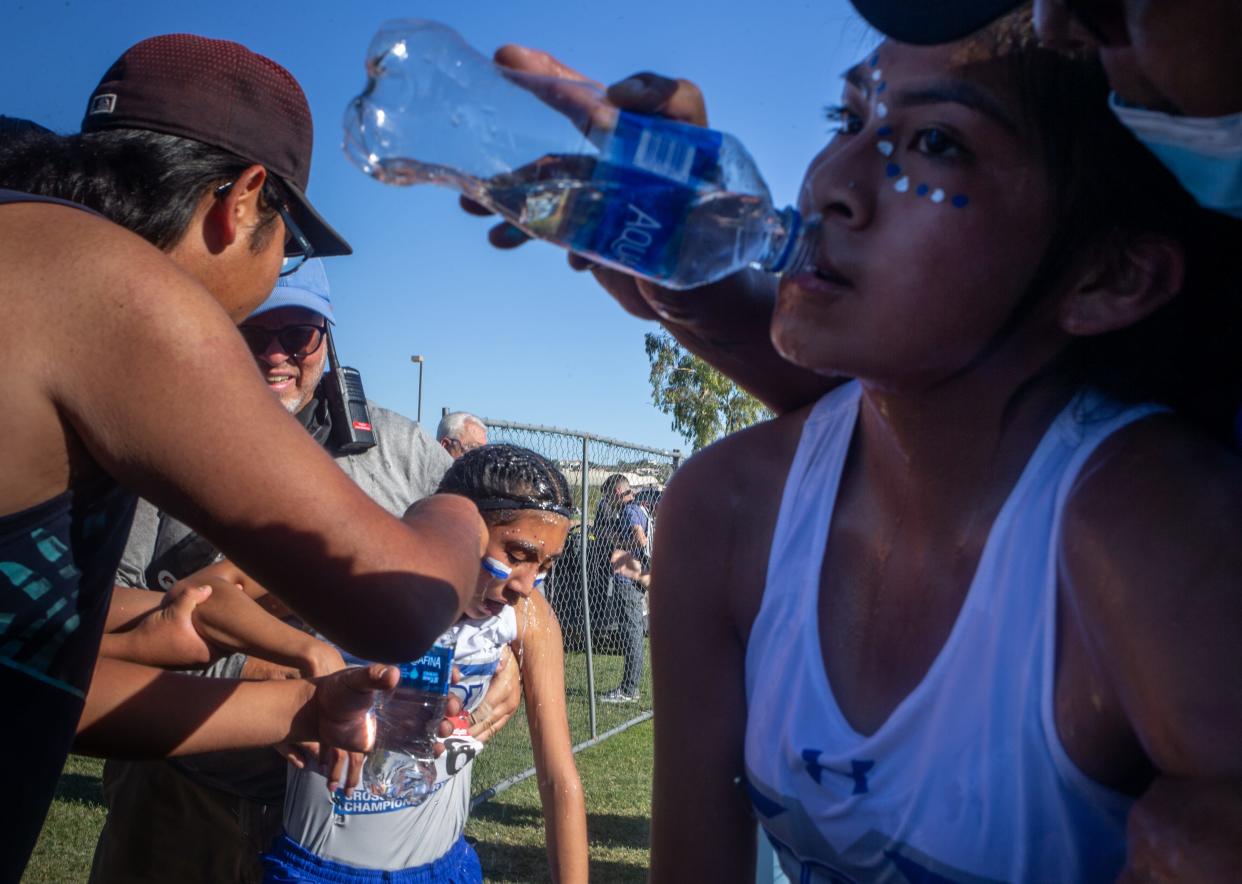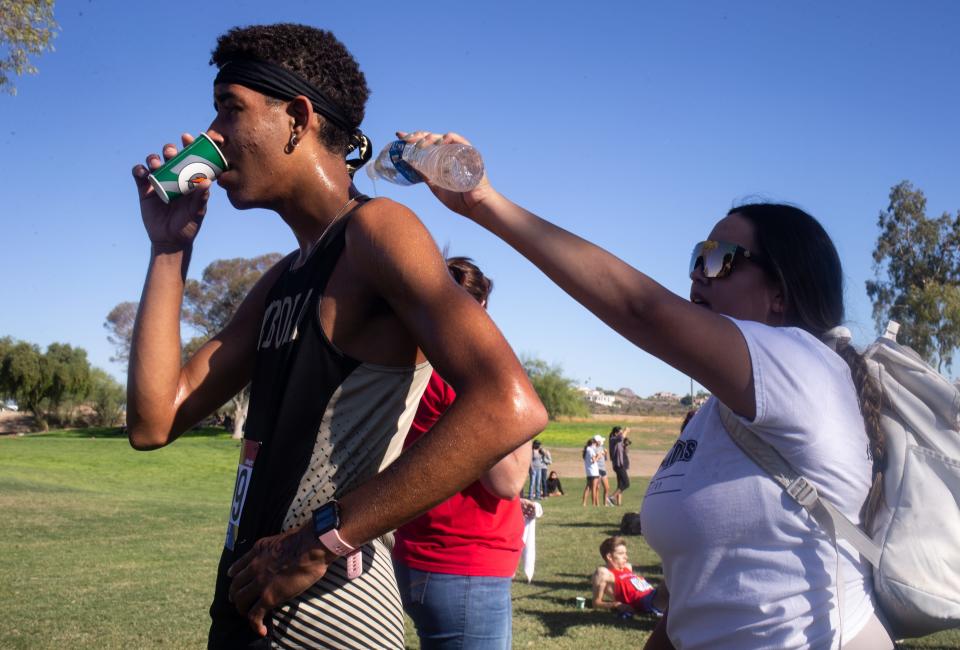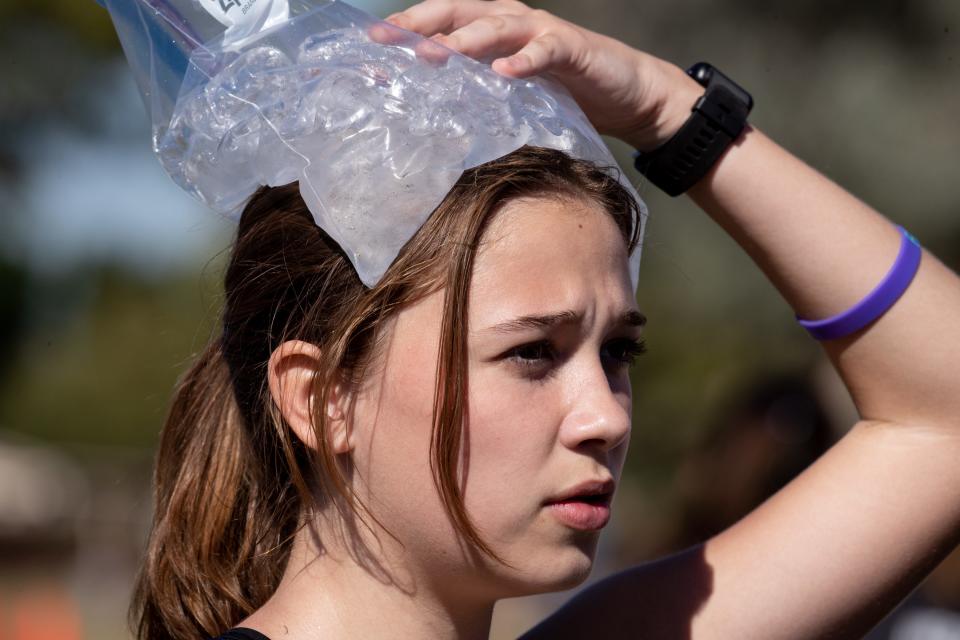Exertional heat stroke is on the rise for athletes. Could tracking urine be the answer?

Corrections & Clarifications: An earlier version of the article cited an incorrect research journal for a study. The study appeared in the journal Dietetics.
If climate change has a color, it might be a deep shade of yellow.
Floris Wardenaar, assistant professor of nutrition at Arizona State University's College of Health Solutions, creates this tint and a range of lighter yellow hues in his lab by mixing different amounts of juice, soda or coffee in clear cups of water.
Then he puts them in front of college athletes and tells them to imagine it's their urine.
With risks of heat illness rising in a warming climate, Wardenaar wants to know if students are able to accurately assess their own hydration status by observing the color of their urine. As part of his research into the needs of active populations living in a hot and dry environment, he creates and studies fake urine as an antidote, of sorts, to increasing temperature averages and extremes.
Thirty-five student athletes at ASU signed up for Wardenaar's test: 19 female lacrosse players, 11 female triathletes and five male members of the football team. The results, published last month in the International Journal of Sports Science and Coaching, show that their eyes, on average, saw the fake urine as at least one shade lighter than it really was. This was especially true when the actual color was on the darker — more dehydrated — end of the spectrum.
These findings build on a body of research confirming that urine color is a reasonable indicator of its water content, regardless (mostly) of any supplements taken. It also follows an earlier study by Wardenaar, published in February in the journal Dietetics, that detected the same tendency to score urine color lighter than it really is among 189 older athletes.
Together, the results suggest that athletes tend to have overly optimistic perceptions of their hydration status when estimating it based on the color of their urine.
This type of work matters to people like Rebecca Stearns, COO of the Korey Stringer Institute at the University of Connecticut, which was established to address exertional heat illness after the sudden death of the Minnesota Vikings lineman during a practice session in 2001.
Stearns is an exercise physiologist and a seasoned runner. She also frequently works medical aid tents at marathons and has had to revive many dehydrated and overheated athletes after they stumble across the finish line, blinded by their determination to how much they have put themselves at risk.
Series beginning: Phoenix isn't what it once was because of climate change. But it's not too late to save it
Exertional heat stroke, Stearns said, is diagnosed by a body temperature of at least 104 degrees Fahrenheit and concussion-like confusion caused by central nervous system dysfunction. It can happen in a variety of climates and causes the untimely and preventable deaths of about half a dozen high school and college athletes in the United States each year.
“We’ve shown that heat stroke can be 100% survivable," Stearns said. "Of the four main causes of sport-related deaths, heat stroke is also probably the cheapest one to treat. It only takes ice water, submersion therapy and a thermometer."
No one said being an athlete would be comfortable
Exertional heat stroke isn't just about dehydration and ice baths. The importance of being hydrated increases as athletes lose more fluid to sweat on hotter days. But in certain conditions, it won't be enough.
One of the places where Stearns sees the most cases every year is at the 7-mile Falmouth Road Race in Cape Cod, Massachusetts, a destination known more as a summer beach escape than for health-threatening high temperatures. Another is the Marine Corps marathon, where combat-ready athletes may be especially likely to ignore warning signs and push past their limits.
“Heat stroke can happen to the healthiest, most fit, perfectly prepared person," Stearns said. "I think that surprises a lot of people. You can be perfectly hydrated, in the best shape of your life and still get heat stroke. Environmental factors and the intensity of exercise above anything else is going to drive up your body temperature.”

Sweating is the body's way of trying to cool itself down, and the more hydrated you are, the more you can sweat. But that cooling effect only happens when the fluid evaporates directly off the athlete's skin, Stearns explained. In humid settings like Cape Cod, where the water vapor concentration in the air is already high, sweat may just drip from the body, offering little cooling benefit.
Surviving heat stroke depends on a combination of how much the body heats up and how long it stays at that temperature.
“You can survive a temperature of 110 if you cool off quickly, and you can die with a temperature of 106 if you’ve been at that temperature for a long time," Stearns said. "At about 105.5, you have cell death and your body can manage that for about 30 minutes. But at that point if you’re not cooled, your chances for survival go way down."
What's in a footprint? Climate change is not your fault, but that doesn't mean you're off the hook
To give overheated runners their best chance at a full recovery, Stearns and her team work quickly at race medical tents to get the athlete into a tub of cold water, which can absorb excess body heat, and to monitor their internal body temperature using rectal thermometers.
Still, the heat stroke death toll has been on the rise in recent years.
A 2020 heat death report from the Maricopa County Department of Public Heath concluded that the 323 local heat-associated deaths from that year represented a 62% increase over 2019 and a 15-fold increase since 2001. The National Center for Catastrophic Sport Injury Research, based at the University of North Carolina at Chapel Hill, reported 20 fatalities among football players at all levels in 2021. Three of those were recorded as exertional heat stroke deaths.
Consensus: Climate experts say world 'is at a crossroads' but offer hope with concrete actions
Meanwhile, scientists have determined that the steadily rising concentration of climate-warming greenhouse gases in the atmosphere, largely from burning fossil fuels for energy, has already guaranteed a warmer future with additional weather extremes.
"The interesting thing with exertional heat stroke is we’ve been seeing concerning trends where it’s been increasing over the decades, Stearns said. "As opposed to some other injuries we’ve seen in sports like head injuries, where we’ve seen a big decline because of rule changes that have helped to reduce that. Heat illness is staying very relevant for many reasons."
Book review: 'Unruly Planet' explores the human meaning of 'home' and what it will take to defend ours
How to avoid rectal thermometers
At ASU, Wardenaar hopes to help athletes avoid all of the unpleasant realities of overexerting themselves in hot conditions. In addition to testing urine color perception, he has also studied the extent to which athletes are able to acclimatize to heat, or condition their bodies to be able to tolerate exertion at higher temperatures.
In a study published last year in the Journal of Strength and Conditioning Research, Wardenaar tested whether a five-day heat acclimation program could help athletes prepare their bodies for exercise on hotter days. He had seven partially acclimated (Arizona-based) athletes bike for an extra 60 minutes in a temperature-controlled room kept at 95 degrees on five consecutive days, while seven others didn't add anything to their training. Those who did the extra biking registered slightly lower core temperatures and heart rates in a later heat stress test compared with the control group.

The study was small and results were not statistically significant. But the "practical difference" was enough for Wardenaar to practice what he preaches. As a former competitive cyclist, he prepares for Arizona summers by adding 45-minute outdoor biking sessions to his routine. On these excursions, he sometimes tests out different cooling vests, which hold cold water next to the skin, and he uses a "foot hurt" test to gauge how much to push himself.
"Above 115 (degrees), especially later in the day, the tarmac on the road is just very, very hot," he said. "Even when biking, the ground can radiate so much heat that your feet hurt physically. That's personal experience, but I sort of have the feeling that when you feel that, there's nothing much beyond that you can push through."
Keeping your own limits in mind, emulating something like Wardenaar's five-day heat acclimatization program, may be especially beneficial in places like the desert Southwest, where dry air allows sweat to evaporate, aiding cooling. If you're not the type to exert yourself for fun, just getting outside more can help prepare your body for heat.
"Many people in this area are car-bound, so they are not really exposed to the heat," Wardenaar said. "Extending the amount of time that you are out, even just gardening or reading the newspaper out on the porch, can help you to get better prepared for the actual summer heat. And if you keep doing this throughout summer, then normally you would be better able and capable of dealing with the heat."
Safety first
Regardless of an athlete's hydration or acclimatization status, with triple-digit temperatures common in Arizona summers, there's still a physiological point at which your core body temperature will keep rising until you go into the shade or limit your exercise intensity, Wardenaar said.
In July 2021, the Phoenix Parks and Recreation Board voted to close popular hiking trails to the public on days when the National Weather Service issued an excessive heat warning. This usually happens when the heat index, a measurement of how hot the weather feels, exceeds 105 degrees. The decision affected trails on Camelback Mountain and Piestewa Peak, and was met with backlash from recreators who felt they could monitor their own safety.
What to know: Popular Phoenix hiking trails close due to excessive heat
Death counts on these mountains say otherwise. And, while some people might be able to manage it and make good decisions, the risks of granting unprepared hikers access in extreme heat extend to the rescue workers who have to go out in 115-degree conditions to retrieve individuals who overextend themselves.
Without these interventions, and maybe with them, heat casualties are likely to climb alongside the warming influences of climate change. In 2021, the National Weather Service recorded 20 days for which there was a heat warning for Phoenix, 11 in Yuma and 14 in the El Centro area. Numbers for 2022 are not updated, but Phoenix's latest excessive heat warning is in effect, with trails closed Tuesday and Wednesday between 11 a.m. and 5 p.m.
🚨EXCESSIVE HEAT WARNING🚨 Camelback Mountain and Piestewa Peak trails will be closed today 8/30/22 and 8/31/22 from 11am to 5pm, due to the excessive heat. Avoiding excessive heat protects you and our first responders, in case of a rescue. Follow @PhoenixParks for more info! pic.twitter.com/6McnHsLcrm
— Phoenix Fire Dept. (@PHXFire) August 30, 2022
For each of the United States' 480,000 college athletes and 8 million high school athletes, heat is an expanding obstacle to reaching their goals in a warming world. Excessive heat also affects workers in physically demanding or outdoor jobs.
“I don’t know what is going to happen with climate change," Wardenaar said. "We have huge distribution centers in this area that all need to be kept cool. If the actual temperature is rising in our environment and maybe also in a work environment, we need to adapt."
Fossil fuel future? Can 'army of moms' slow climate change to spare children?
Whether being able to accurately identify the exact hue of fake urine could protect athletes and others from heat illness is unclear. (If you're worried, Wardenaar's latest paper suggests that urine color matching can improve with a mere five hours of practice.)
What is clear (get it?), is that the risk of exertional heat illness is rising with average global temperatures, and that none of these deaths should have occurred.
Staying hydrated and monitoring nutrition while exercising, as well as making an effort to acclimate slowly to hotter conditions and paying attention to warning signs, can allow athletes to continue doing what they love and pushing through a hotter future.
The rest of us can help by supporting a societal shift away from fossil fuels, switching to renewable energy sources and keeping in mind that allowing climate change to continue unabated will strike our vulnerable populations and young athletes first and most.
Joan Meiners is the climate news and storytelling reporter at The Arizona Republic and azcentral. Before becoming a journalist, she completed a doctorate in ecology. Follow Joan on Twitter at @beecycles or email her at joan.meiners@arizonarepublic.com.
Please support climate coverage and local journalism by subscribing to azcentral.com at this link.
This article originally appeared on Arizona Republic: Can fake urine help athletes escape heat death in a warming climate?

